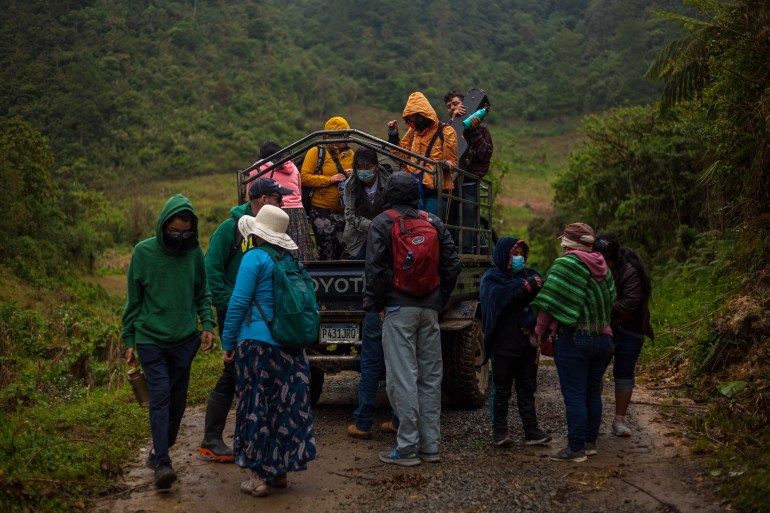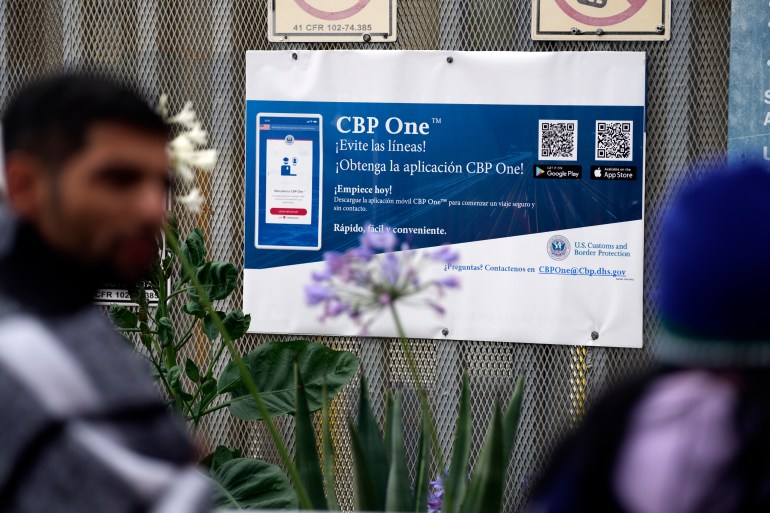Indigenous groups say they are left out of US immigration debate
Indigenous asylum seekers from Latin America often face language barriers and discrimination on their journey to the US.

As the United States enacts numerous policies that critics say restrict access to asylum, rights groups have expressed concern that such policies could have especially severe impacts on Indigenous migrants.
While narrowing asylum pathways has thrown life into flux for many of those seeking refuge in the US, Indigenous people say that the obstacles they face – from language barriers to discrimination and violence – have gone largely unrecognised in conversations about immigration.
Keep reading
list of 3 itemsEcuador: Indigenous villages fight ‘devastating’ mining activity
Killing of Indigenous Ecuador anti-oil activist spurs questions
“We don’t migrate for a good life. We’re forced to leave. Parents send their children on this journey to save their lives,” said Geronimo Ramirez, a Maya-Ixil community organiser who lives in the US and works with the International Mayan League, a Maya-led human rights organisation.
“But we have been invisible. In immigration statistics, we’re characterised as Latino or Hispanic. Our identity has been assassinated.”
Indigenous advocacy organisations say the demand for asylum will only become more urgent, as their communities face displacement from climate change and violence from groups who target opposition to industrial projects on ancestral land.

Rolling back asylum
Earlier this year, the administration of US President Joe Biden announced a series of policies designed to discourage migrants and asylum seekers from crossing the country’s southern border irregularly.
One would render most of those arriving at the border ineligible for asylum, by requiring that they first apply for protection in the countries they passed through before reaching the US.
Immigration rights groups have slammed the policy as a “transit ban” and compared it to a similar “safe third country” rule implemented under former President Donald Trump.
Many also point out that migrants and asylum seekers travelling through Central American countries are often subject to violence and exploitation, with abusive authorities and criminal groups targeting them for extortion and other crimes.
In June, 143 immigration and human rights groups issued a letter to the Biden administration, urging more flexibility when processing Indigenous asylum claims.
“Indigenous Peoples should not be subject to the Asylum Ban for failure to seek asylum in a transit country, given the mistreatment of Indigenous Peoples by the governments of many transit countries,” the letter read.

Indigenous identity a target
For people of Indigenous backgrounds, discrimination can make the dangers more acute.
“People can spot if you’re Indigenous from the food you eat, the language you’re speaking,” said Julisa Garcia, an Indigenous Kaqchikel organiser with Promotores de la Liberacion Migrante, an immigrant and Indigenous rights group in Guatemala.
She has noticed that some Indigenous people abandon traditional clothing patterns when making the journey north in order to avoid drawing attention to their identity. Otherwise, she said, “you’re stigmatised as a delinquent”.
Language barriers can also leave Indigenous migrants more vulnerable to abuse.
In one high-profile instance, a Mayan Chuj woman from Guatemala named Juana Alonzo Santizo was kidnapped on her way to the US border and forced to work for her captors in Mexico.
When police broke up the kidnapping ring, they accused Santizo herself of human trafficking. But unable to speak Spanish, she could not deny the allegations. She has since alleged that police beat her and threatened her with a gun, forcing her to sign a confession she did not understand. There was no translator present to help her, she said.
Only in May 2022 was she released, after seven years without a trial. A Mexican court ultimately found no consistent evidence against her.

Language a barrier in proceedings
Language barriers can also carry over into the immigration process, with Indigenous people struggling to communicate with officials or find legal representation.
“Most immigration law offices will have fluent Spanish speakers on staff, but it’s more difficult to find translators for Indigenous languages,” said Victoria Neilson, a lawyer at the National Immigration Project, one of the signatories to the June letter to the Biden administration.
Neilson also pointed to problems with the increasing use of the CBP One, a mobile application launched in 2020 and expanded under President Biden as the main portal for scheduling appointments with border authorities.
The app, which has been criticised as defective and difficult to use, does not include Indigenous languages.
Neilson explained that applicants can ask for exemptions from the app based on language, but they nevertheless have to prove they were unable to complete the process with the help of a third party.
The Biden administration itself has acknowledged that language barriers may hinder Indigenous peoples as they navigate the US immigration system.
In a June memo from the Executive Office for Immigration Review (EOIR), officials wrote that immigration judges “should be cognizant that some noncitizens have limited proficiency in the dominant language spoken in their country of origin” and “are fluent only in an Indigenous language”.
However, Neilson notes that the memo does not apply to the Department of Homeland Security or pertain to the CBP One app.

Legacies of violence
Organisations such as the International Mayan League are quick to underscore the connection they see between today’s migration crisis and the colonial forces that have displaced Indigenous people for centuries.
Increasingly, Indigenous groups in Latin America are forced to compete with business interests – legal or otherwise – for control of their ancestral lands. Those conflicts can lead to outright violence, as opponents try to silence or expel Indigenous activists.
A report from the environmental nonprofit Global Witness found that Indigenous people comprised 40 percent of the fatal attacks recorded against land and environmental defenders in 2021.
Another analysis, from the Irish-based nonprofit Front Line Defenders, found that 22 percent of all human rights defenders killed in 2022 were Indigenous, making them one of the most at-risk groups relative to their population size.
In 2019, for instance, four community leaders working with the Indigenous-led political organisation CODECA were killed in a single month in Guatemala, a state where a previous US-backed government carried out a genocide against the Maya population that killed 200,000 people.
And last December, an Indigenous community leader in neighbouring Honduras also survived an apparent assassination attempt after organising efforts to stop displacement by local landowners.
“We see a clear connection between the imposition of transnational extraction and the lack of respect for Indigenous sovereignty, land rights and, in turn, forced displacement,” said Lorena Brady, policy and programme manager at the International Mayan League.

Climate change fuelling displacement
Brady also pointed out the disproportionate effects of climate change on Indigenous communities, some of whom are reliant on their immediate environment for basic needs.
“Indigenous people have done the least to contribute to climate change, but they’re going to suffer some of the worst effects. We would like to see the US create a classification for people seeking refuge due to climate displacement,” she said.
With Indigenous economies left fragile by the ravages of climate change, some residents face barriers to employment even outside of their communities.
“There’s this term going around calling Honduras, Guatemala, Nicaragua and El Salvador ‘the dry corridor’. It’s becoming desert-like,” said Lizbeth De La Cruz Santana, an assistant professor at Baruch College in New York who has studied migration across the US-Mexico border.
“What happens when that land is no longer fertile? What happens when this land can no longer serve as a source of income, and beyond that, as a source of food?”
A 2022 study published in the Journal of Migration Health pointed to economic poverty and “exclusionary state policies” as primary motivations for Indigenous people leaving Guatemala for the US. Some communities, the study pointed out, lacked “paved roads and basic social services”.
“The ones who are at fault are the governments who don’t guarantee the rights of its people,” said Ana Gomez, founder of Promotores de la Liberacion Migrante.
“When there is a flood or some kind of displacement, people have no choice but to migrate. The situation is not going to change because there is no plan to improve people’s lives.”
Gomez warns that, as climate change worsens, the processes displacing Indigenous people may speed up, funnelling more people into an immigration system with little understanding of their unique vulnerabilities.
“We are always processed as Central Americans, not Indigenous,” she said. “There needs to be more awareness about the rights of Indigenous people.”